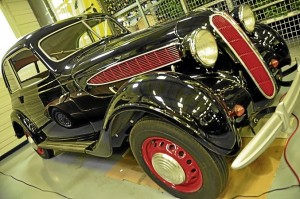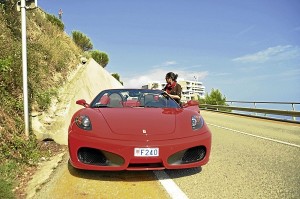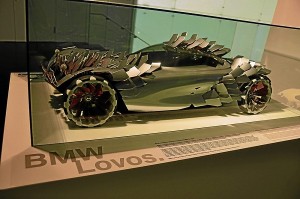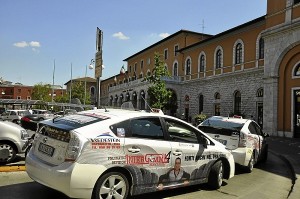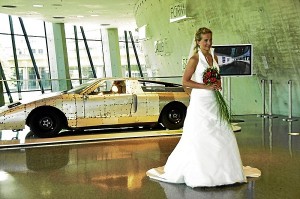2011: The year of driving ‘out of the ordinary’
Guilty as charged, your Honor.
I must admit that, despite the doom-and-gloom scenarios of dwindling oil supplies, skyrocketing fuel prices, and the increasing effects of climate change brought to us in great part by the never-ending activities of the motoring industry, I still thoroughly enjoyed the trips and test drives here and abroad. The most memorable ones, of course, were those that brought me face-to-face, or face-to-fascia, with the legendary automobiles, with some even allowing me the pleasure of being behind the wheel.
Here are my top 11 memorable encounters with iconic, historic, most technologically endowed, or just plain strange automobiles. Then I’ll go back to writing about the fuel misers next year, hopefully before we all run out of time like the ancient Mayans predicted it.
1.) Ferrari F430 F1 Spider. During my seven-country solo European tour in August, this encounter in the French Riviera certainly counts as the crowning glory. My drive with this ethanol-powered supercar lasted 30 minutes, 235 euros and lots of gigabytes in my DSLR. It was a drive as close to perfection as I could get. First, for the route: Starting in a perfume factory in the picturesque medieval Eze Village, proceeding to Moyenne Corniche between Nice and Monaco. Second, the car: It was a Ferrari F430 F1 Spider. No introduction needed.
2.) A solar-powered BMW “porcupine.” I spotted this concept car, called BMW Lovos (which means Lifestyle of Voluntary Simplicity), in the BMW Museum in Munich, Germany. Its designer is Anne Forschner, a German who graduated from Pforzheim University. One blogger described it as looking like a porcupine; Popular Science wrote a feature on this strange-looking beast. It is strange for a purpose. Its 260 exterior flaps, when they are not raised, collect solar power. When they are, they act as air brakes.
3.) Toyota Prius. It’s rare here in Manila because it’s just too expensive. But in Pisa, Italy, they are used as taxis. Just the same, that feeling of exclusivity was still there when I test-drove the 3rd Generation Prius from Manila to Aklan and back a couple of months earlier.
4.) The Ford Fiesta. Who says fiestas are exclusive to the Philippines? In Milan, I spotted, and even drove, the Ford Fiesta. But that driving experience was nothing compared to the exhausting local adventure with the Fiesta starting from Manila to Ilocos Province and back.
5.) BMW 321, circa 1949. Even amidst devastating defeats in two world wars, Germany remained masterful at crafting automobiles. One fine example is this 1949 BMW 321 produced at the Eisenach plant, now resting and gathering greater legendary status at the Manro Car Museum in Salzburg.
6.) Mercedes 190 (W201). Berlin-based sculptor Michael Sailstorfer was commissioned to do “real collage” work for the Daimler Art Collection. He rebuilt a Mercedes 190 (W201) into the C111. I found this “transformational” work at the Benz Museum in Stuttgart, Germany, which is also a popular place for German brides and newlyweds to get those once-in-a-lifetime photos.
7.) Volvo C30. This classy compact was voted the Car of the Year-Philippines in 2007, the first and only premium European car brand awarded that title so far. It was also one of the more popular displays during the Manila International Auto Show this April. The sporty rear glass hatch is reminiscent of the classic Volvo P1800 ES, with ample rear view for safer driving. The reintroduced variant is of a smaller engine displacement from the original C30 (from 2.4-liter to 2.0-liter); but then there is also the new 2.5-liter C30 T5 for more spirited driving. I was able to drive the 2.0 L Powershift unit (with colorful stickers to boot), courtesy of Viking Cars Inc.
8.) BMW 1 Series. There could be only One, but I was able to drive it in two locations thousands of kilometers apart. The all-new 120d (which is not locally available) I was able to take a spin from Brandenburg to Berlin. Recently, our group of motoring scribes drove the 116i and 118i (Sport) from Alabang to Tagaytay and back. The One Series performed consistently well in two very different locations.
9.) Hyundai Genesis. This Korean sports car’s “genesis” has been so meteoric that, in less than a year of its introduction in the Philippines, it already has its own owners’ club, the Genesis Coupe Club. The accolades keep pouring in, as it won the Metro’s Finest Korean Ride at the 2010 Metro Rides in June 2010 for its overall performance, durability and style. I was able to drive a head-turning yellow Genesis here in Manila, and I have to say, this could, indeed, be the start of many good things for Hyundai in the sports car category.
10.) The Lexus Fuji Apex. This is one ultra-elusive rear-wheel drive supercar. With only 500 ever being built, and only one given to Lexus Manila for display purposes only, the Lexus LFA is described as embodying everything that the Lexus brand stands for, and everything that Lexus is capable of. The sound of the engine alone stupefies. It’s not a drug, but it will take its lucky owner on a natural high. Unfortunately, the lone P40-million dream car on local soil isn’t for sale. I volunteer to warm the engine up once a week.
11.) Arzens Biplace L’oeufa (or Arzens Electric Egg as its first version was powered by electric motor). It was hard to ignore this curious vehicle (made out of hand-formed aluminum and Plexiglass windscreen and doors), sitting silently in a spot at the Cite de Automobile in France. This car was built in 1942, but its maker Paul Arzens—an industrial designer who was described as having an imagination without boundaries—was certainly thinking beyond his time, and even drew the attention of a passing Parisian whose name was Etto Bugatti. Its 1-cylinder 125 cc engine could make the contraption run as fast as 80 kph.

